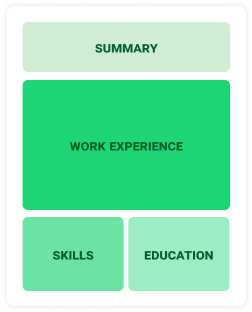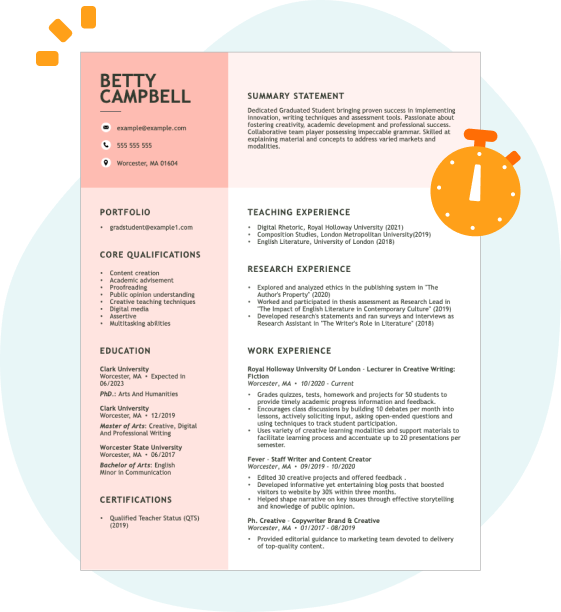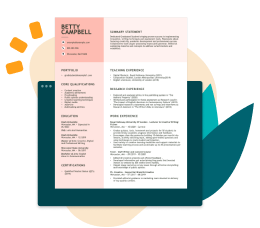Hard skills are technical abilities such as programming in C/C++, knowledge of embedded operating systems, and hardware interfacing that play a key role in designing and optimizing embedded systems.
Popular Embedded Systems Engineer Resume Examples
Discover our top embedded systems engineer resume examples that emphasize critical skills like software development, hardware integration, and troubleshooting. These samples are crafted to help you effectively showcase your accomplishments in this dynamic field.
Ready to build your standout resume? Our Resume Builder provides user-friendly templates specifically tailored for engineers, making the process straightforward and efficient.
Entry-level embedded systems engineer resume
This entry-level resume for an embedded systems engineer effectively highlights the job seeker's technical skills and accomplishments in developing IoT solutions and optimizing system performance. New professionals in this field need to demonstrate their skill with relevant technologies and showcase project successes, even when they have limited industry experience.
Mid-career embedded systems engineer resume
This resume effectively highlights the engineer’s advanced skills and leadership achievements, demonstrating readiness for complex challenges. The strategic presentation of accomplishments and certifications shows a solid career progression in embedded systems engineering.
Experienced embedded systems engineer resume
This resume illustrates the applicant's extensive experience as an embedded systems engineer, demonstrating significant achievements like developing over 10 IoT applications and reducing debugging time by 30%. The bullet points improve readability, making it easy for hiring managers to identify key accomplishments at a glance.
Resume Template—Easy to Copy & Paste
Daniel Wilson
Milwaukee, WI 53203
(555)555-5555
Daniel.Wilson@example.com
Professional Summary
Dynamic Embedded Systems Engineer with 6 years' experience in firmware, IoT solutions, and system optimization, adept at performance enhancement and efficiency improvement.
Work History
Embedded Systems Engineer
Techtron Innovations - Milwaukee, WI
November 2023 - October 2025
- Designed low-power systems, reducing costs by 15%
- Implemented firmware updates, boosting performance by 20%
- Collaborated on IoT projects, increasing efficiency
Firmware Developer
MicroTech Solutions - Brookfield, WI
November 2021 - October 2023
- Developed embedded software, improving latency 30%
- Optimized codebase, cutting execution time by 25%
- Designed debugging tools, enhancing workflow
Systems Programmer
InnovaTech Systems - Milwaukee, WI
November 2019 - October 2021
- Designed algorithms, boosting processing speed 40%
- Implemented cross-platform solutions improving compatibility
- Tested software ensuring zero errors
Languages
- Spanish - Beginner (A1)
- Mandarin - Intermediate (B1)
- German - Beginner (A1)
Skills
- Embedded Systems Design
- Firmware Development
- Hardware Integration
- IoT Solutions
- Performance Optimization
- Low-Power Systems
- Algorithm Design
- Cross-Platform Development
Certifications
- Certified Embedded Systems Developer - Embedded Systems Institute
- Advanced IoT Developer - IoT Consortium
Education
Master of Science Embedded Systems
University of California, Berkeley Berkeley, CA
June 2019
Bachelor of Science Electrical Engineering
Stanford University Stanford, CA
June 2017
How to Write a Embedded Systems Engineer Resume Summary
Your resume summary is the first impression employers will have of you, making it important to craft a compelling introduction. As an embedded systems engineer, it’s essential to highlight your technical skills and experience in designing and implementing complex systems.
Focus on showcasing your skill in programming languages, hardware integration, and problem-solving abilities. This is your opportunity to demonstrate how your background aligns with the job requirements.
To illustrate what makes an effective resume summary, here are some examples that will clarify best practices and common pitfalls:
Weak resume summary
I am an embedded systems engineer with a broad background in various projects. I seek a position where I can use my skills to contribute positively to the company and grow professionally. A collaborative environment that encourages innovation is what I prefer, as I believe it would help me make significant contributions.
- Lacks specific examples of skills or accomplishments relevant to embedded systems engineering
- Emphasizes personal desires instead of highlighting how the job seeker can add value to potential employers
- Contains generic phrases that do not differentiate the job seeker from others in the field
Strong resume summary
Results-driven embedded systems engineer with over 7 years of experience in designing and optimizing firmware for real-time applications. Achieved a 30% increase in system efficiency by implementing advanced power management algorithms in IoT devices. Proficient in C/C++, MATLAB, and hardware-software integration, with a strong focus on quality assurance and testing methodologies.
- Begins with a clear statement of experience level and specialization in embedded systems
- Highlights quantifiable achievement that reflects significant improvements in system performance
- Includes specific technical skills relevant to the role, showcasing expertise that employers seek
PRO TIP
Showcasing Your Work Experience
The work experience section is the centerpiece of your resume as an embedded systems engineer. This area will contain the bulk of your content, and good resume templates always emphasize this important section.
Your work history should be organized in reverse-chronological order, detailing your past positions. Use bullet points to succinctly highlight your achievements and contributions in each role.
To provide clarity, we’ll present a couple of examples that demonstrate effective entries for embedded systems engineers. These examples will showcase what works well and what to avoid:
Embedded Systems Engineer
Tech Innovations Inc. – Austin, TX
- Worked on software for embedded devices.
- Collaborated with team members.
- Tested and debugged systems.
- Assisted in project documentation.
- Lacks specific employment dates to establish timeline
- Bullet points are too vague and do not highlight key skills or accomplishments
- Emphasizes routine tasks instead of showcasing strong contributions
Embedded Systems Engineer
Tech Innovations Inc. – San Jose, CA
March 2020 - Present
- Develop firmware for microcontroller-based systems, improving product performance by 30%.
- Collaborate with hardware engineers to design and implement robust testing protocols, reducing defect rates by 15%.
- Lead project teams in Agile sprints, improving delivery speed and increasing stakeholder satisfaction scores by 20%.
- Uses strong action verbs to convey the job seeker's contributions effectively
- Incorporates specific percentages to highlight measurable improvements in performance and quality
- Showcases collaboration and leadership skills that are essential for success in embedded systems engineering
While your resume summary and work experience are important, it’s important not to overlook the other sections that contribute to a well-rounded presentation. For detailed insights on crafting each part of your resume effectively, please refer to our comprehensive guide on how to write a resume.
Top Skills to Include on Your Resume
A well-defined skills section is important for any resume, as it allows hiring managers to quickly identify whether you possess the necessary qualifications. This section acts as a snapshot of your competencies and can set you apart from other job seekers.
As an embedded systems engineer, emphasize technical skills that showcase your expertise in hardware and software integration. Highlight your skill with tools like MATLAB, C/C++, and embedded Linux systems to demonstrate your capability in this specialized field.
Soft skills, including problem-solving, teamwork, and effective communication, are essential for collaborating with cross-functional teams and driving project success in dynamic environments.
Selecting the right resume skills is important for meeting employer expectations and passing automated screening systems. Many companies use software to filter out applicants who lack essential qualifications for the position.
To improve your chances of success, carefully review job postings to identify which skills are emphasized. By aligning your resume with these requirements, you’ll capture the attention of recruiters and improve your standing in ATS evaluations.
PRO TIP
10 skills that appear on successful embedded systems engineer resumes
Highlighting key skills on your resume can significantly capture the attention of recruiters looking for embedded systems engineers. Our resume examples illustrate how these skills are effectively presented, empowering you to apply confidently.
By the way, consider adding relevant skills from the following list that match your qualifications and job requirements:
Embedded programming
Circuit design
Real-time operating systems (RTOS)
Debugging techniques
Microcontroller skill
Communication protocols
Software development life cycle (SDLC)
Problem-solving abilities
Collaboration skills
Analytical thinking
Based on analysis of 5,000+ engineering professional resumes from 2023-2024
Resume Format Examples
Choosing the right resume format is important for effectively showcasing an embedded systems engineer's technical skills, experience, and career development.
Functional
Focuses on skills rather than previous jobs

Best for:
Best for recent graduates and career changers with up to two years of experience
Combination
Balances skills and work history equally

Best for:
Mid-career professionals focusing on their skills and potential for growth
Chronological
Emphasizes work history in reverse order

Best for:
Seasoned engineers leading complex embedded system projects
Frequently Asked Questions
Should I include a cover letter with my embedded systems engineer resume?
Absolutely. Including a cover letter is a great way to highlight your skills and show your enthusiasm for the position. It adds depth to your resume by connecting your experiences with the job requirements. If you need assistance, explore our tips on how to write a cover letter or use our Cover Letter Generator for quick help in crafting yours.
Can I use a resume if I’m applying internationally, or do I need a CV?
For international applications, use a CV when applying to positions that require detailed academic and professional histories. It's essential for roles in academia or research. To learn how to write a CV effectively, explore our resources on proper formatting. Additionally, check out CV examples that can guide you in creating an effective CV for your job search.
What soft skills are important for embedded systems engineers?
Soft skills in embedded systems engineering, such as problem-solving, collaboration, and interpersonal skills, are essential. They enable engineers to work seamlessly with cross-functional teams and effectively convey complex ideas, ensuring successful project outcomes and innovation.
I’m transitioning from another field. How should I highlight my experience?
Highlight your transferable skills such as analytical thinking, project management, and teamwork when applying for embedded systems engineer positions. These abilities show your potential to adapt and excel in this technical field. Share specific examples from previous roles that illustrate how you solved problems or improved processes, making clear connections to the responsibilities of an embedded systems engineer.
Should I include a personal mission statement on my embedded systems engineer resume?
Yes, including a personal mission statement on your resume is highly recommended. It helps convey your core values and career aspirations effectively. This strategy is especially useful when applying to tech companies that emphasize innovation and align strongly with their mission or culture.
How do I add my resume to LinkedIn?
To increase your resume's visibility on LinkedIn, you can add your resume to LinkedIn by uploading it directly to your profile. Alternatively, highlight essential skills and projects in the "About" and "Experience" sections. This approach helps recruiters easily identify qualified embedded systems engineers, improving the likelihood of being discovered for relevant opportunities.







